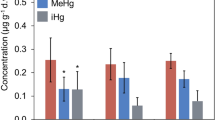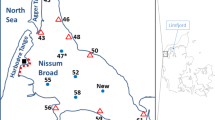Abstract
Mussels (Mytilus edulis) transferred in net bags from clean to chronically mercury polluted water readily accumulated mercury during an exposure period of three months. Growth of the transplanted mussels had a “diluting” effect on the mercury concentration, but the absolute weight of mercury uptake increased throughout the entire period, though there was a tendency for decreased efficiency of the removal of mercury per liter of water filtered by the mussels. Mussels were also translocated from polluted to clean (laboratory) water to depurate mercury. The biological half-lives of mercury was 293 d for M. edulis from the chronically polluted area in contrast to only 53 d for mussels from a temporary massive mercury polluted area near a chemical deposit. In both cases about 75% of the total mercury in the mussels was inorganic, and it is suggested that both inorganic and organic mercury species were immobilized in mussels from the long-term mercury polluted area, whereas the immobilization capacity was exceeded in the short-term mercury exposed mussels near the chemical deposit. Very slow elimination of mercury was observed in the deposit-feeding bivalve Macoma balthica from the chronically polluted area, and about 6% of the total mercury was methyl-+phenyl-mercury. This is more than three times lower than found in M. edulis from the same collecting site. A pronounced difference in the mercury speciation (i.e., total mercury, total organic mercury, methyl-mercury and phenyl-mercury) in M. edulis from the two mercury polluted areas is thought to reflect the different character of the mercury pollution in the two areas.
Similar content being viewed by others
Literature cited
AOAC Methods: Mercury Flameless atomic absorption methods. 25.113–25.114, p. 406, Washington, DC: AOAC 1980
Beijer, K. and A. Jernelöv: Methylation of mercury in aquatic environments. In: The biogeochemistry of mercury in the environment, pp 203–210. Ed. by J. O. Nriagu. Elsevier: North-Holland Biomedical Press 1979
Bøhle, B.: Blåskjell og blåskjelldyrkning. Rapporter og meldinger fra fiskeridirektoratets havforskningsinstitut i Bergen (In Norwegian). Fisken Hav. B. 3, 1–19 (1974)
Cunningham, P. A. and M. R. Tripp: Factors affecting the accumulation and removal of mercury from tissues of the American oyster Crassostrea virginica. Mar. Biol. 31, 311–319 (1975 a)
Cunningham, P. A. and M. R. Tripp: Accumulation, tissue distribution and elimination of 203HgCl2 and CH3 203HgCl in the tissues of the American oyster Crassostrea virginica. Mar. Biol. 31, 321–334 (1975b)
Currie, L. A.: Limits for qualitative detection and quantitative determination. Application to radiochemistry Anal. Chem. 40, 586–593 (1968)
Davies, I. M. and J. M. Pirie: The mussel Mytilus edulis as a bioassay organism for mercury in seawater. Mar. Pollut Bull. 9, 128–132 (1978)
Davies, I. M., W. C. Graham and J. M. Pirie: A tentative determination of methyl-mercury in sea-water. Mar. Chem. 7, 111–116 (1979)
Denton, G. R. W. and C. Burden-Jones: Influence of temperature and salinity on the uptake, distribution and depuration of mercury, cadmium and lead by the black-lip oyster Saccostrea echinata. Mar. Biol. 64, 317–326 (1981)
Dillon, T. M. and J. M. Neff: Mercury and the estuarine march clam, Ragnia cuneata Gray. II. Uptake, tissue distribution and depuration. Marine environ. Res. 1, 67–77 (1978)
Drabæk, I. and V. Carlsen: Comparison of different analytical techniques for the determination of organic mercury. Int. J. environ. Anal. Chem., 17, 231–239 (1984)
Eganhouse, R. P. and D. R. Young: In situ uptake of mercury by the intertidal mussel, Mytilus californianus. Mar. Pollut. Bull. 9, 214–217 (1978)
Fowler, S. W., M. Heyraud and J. La Rosa: Factors affecting methyl and inorganic mercury dynamics in mussels and shrimp. Mar. Biol. 46, 267–276 (1978)
Jensen, K. O. and V. Carlsen: Low level mercury analysis by neutron activation analysis. J. radiat. Chem. 47, 121–134 (1978)
Kiørboe, T., F. Møhlenberg and H. U. Riisgåard: Mercury levels in fish, invertebrates and sediment in a recently recorded polluted area (Nissum Broad, Western Limfjord, Denmark). Mar. Pollut. Bull. 14, 21–24 (1983)
Kopfler, F. C.: The accumulation of organic and inorganic mercury compounds by the eastern oyster (Crassostrea virginica). Bull. environ. Contam. Toxicol. 11, 275–280 (1974)
Langston, W. J.: The distribution of mercury in British estuarine sediments and its availability to deposit-feeding bivalves. J. mar. biol. Ass. U.K., 62, 667–684 (1982)
Miettinen, J. K., M. Heyraud and S. Keckes: Mercury as a hydrospheric pollutant. II. Biological half-time of methyl mercury in four Mediterranean species: a fish, a crab, and two molluscs. In: Marine pollution and sea life, pp 295–298. Ed. by M. Ruivo. London: Fishing News (Books) 1970
Møhlenberg, F. and H. U. Riisgård: Filtration rate, using a new indirect technique, in thirteen species of suspension-feeding bivalves. Mar. Biol. 54, 143–148 (1979)
Okazaki, R. K. and M. H. Panietz: Depuration of twelve trace metals in tissues of the oyster Crassostrea gigas and C. virginica. Mar. Biol. 63, 113–120 (1981)
Pentreath, R. J.: The accumulation of inorganic mercury from sea water by the plaice, Pleuronectes platessa L. J. exp. mar. Biol. Ecol. 24, 103–119 (1976a)
Pentreath, R. J.: The accumulation of organic mercury from sea water by the plaice, Pleuronectes platessa L. J. exp. mar. Biol. Ecol., 24, 121–132 (1976b)
Perkin Elmer: Analytical methods for atomic absorption spectroscopy using the MHS mercury hydride system, 80 pp. Überlingen: Perkin Elmer 1981
Riisgård, H. U. and E. Poulsen: Growth of Mytilus edulis in net bags transferred to different localities in a eutrophicated Danish fjord. Mar. Pollut. Bull. 12, 272–276 (1981)
Riisgård, H. U.: Mercury pollution in the waters around Harboøre Tange and Limfjord, Denmark. Mar. Pollut. Bull. 15, 129–133 (1984)
Sloan, J. P., J. A. J. Thompson and P. A. Larkin: The biological helf-life of inorganic mercury in the dungeness crab (Cancer magister). J. Fish. Res. Bd Can. 31, 1571–1576 (1974)
Starý, J. and J. Prášilová: Radiochemical determination of methyl-mercury chloride. II. Exchange reaction with labelled iodide. Radiochem. Radional. Lett. 27, 51–56 (1976a)
Starý, J. and J. Prášilová: Determination of phenylmercury chloride in the presence of methylmercury chloride. Radiochem. Radioanal. Lett. 26, 33–38 (1976b)
Starý, J., B. Havlik, J. Prášilová, K. Kratzer and J. Hanušova: Radiochemical determination of methylmercury in fish. Radiochem. Radioanal. Lett. 35, 47–52 (1978)
Ünlü, M. Y., M. Heyraud and S. Keckes: Mercury as a hydrospheric pollutant. I. Accumulation and excretion of 203HgCl2 in Tapes decussatus L. In: Marine pollution and sea life, pp 292–295. Ed. by M. Ruivo. London: Fishing News (Books) 1970
Yamamoto, J., Y. Kaneda and Y. Hikasa: Picrogram determination of methylmercury in seawater by gold amalgamation and atomic absorption spectrophotometry. Int. J. environ. Anal. Chem. 16, 1–16 (1983)
Author information
Authors and Affiliations
Additional information
Communicated by T. Fenchel, Aarhus
Rights and permissions
About this article
Cite this article
Riisgård, H.U., Kiørboe, T., Møhlenberg, F. et al. Accumulation, elimination and chemical speciation of mercury in the bivalves Mytilus edulis and Macoma balthica . Marine Biology 86, 55–62 (1985). https://doi.org/10.1007/BF00392579
Accepted:
Issue Date:
DOI: https://doi.org/10.1007/BF00392579




